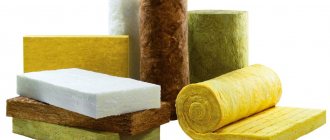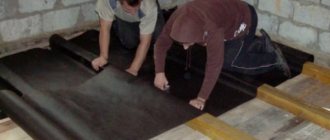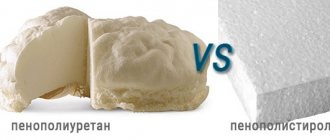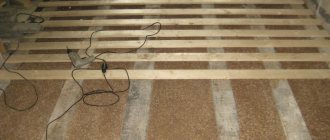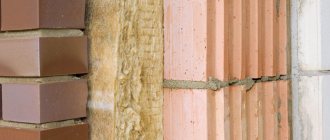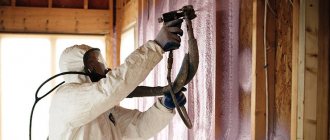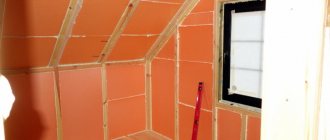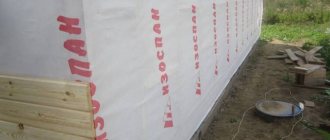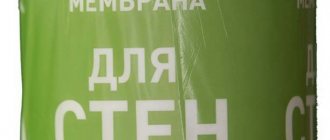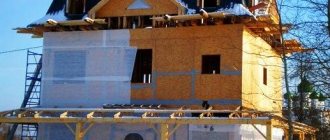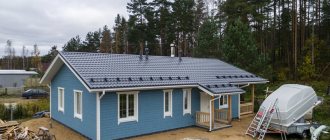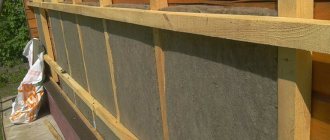Modern finishing construction work cannot be done without the use of mineral wool, because, as you know, this is the most economical and effective option for thermal insulation. The method of insulating walls under plaster using mineral wool is called wet facade technology.
This method consists of performing external installation of heat-insulating boards, which will later be plastered. This technology makes it possible to create a multi-layer, durable structure that will reliably protect the house from cold and strong winds.
What is a wet façade?
Insulation of facades with wet plaster is complex work on external insulation of walls and their finishing, which is carried out with wet solutions, such as adhesives and plaster. The coating consists of the following main layers:
- Glue. Thanks to it, thermal insulation boards are fixed and the walls of the building are leveled.
- Thermal insulation is the main insulating layer.
- A reinforcing layer for which a plaster-adhesive base and fiberglass reinforcing mesh are used. This allows you to increase the strength characteristics of the structure.
- Decorative finishing. It is used to protect walls from external influences and shape the architectural appearance of the house.
Plastering facades for the purpose of insulation involves the additional use of the following elements:
- Primer - used to treat the main wall, reinforcing layer and decorative plaster before painting it.
- Disc-shaped dowels - allow you to attach insulation to the wall.
- Perforated corner profile - used to form and strengthen corners.
- Perforated base profile - installed on the lower load-bearing element of the covering structure.
Advantages of wet facades
Using the wet finishing method allows you to create architectural styles that will be in fashion for at least another 20 years. Such houses have an expensive and substantial appearance, despite the fact that their cost is the lowest. The use of basalt wool and plaster has many advantages, among which are:
- significant reduction in heat loss of the building due to reduced thermal conductivity of the entire structure;
- a huge number of existing architectural solutions;
- safety of internal space;
- insulation and plastering of facades not only during construction work, but also if the buildings are already in operation;
- reducing costs for heating and air conditioning of buildings;
- good soundproofing properties of the finish;
- creating a favorable indoor microclimate;
- increasing the service life of the building;
- no load on the building structure;
- low cost;
- ease of installation;
- ease of material replacement and repair.
Disadvantages of wet facades
The disadvantages of this method include the seasonality factor of installation work. According to the technology, laying a wet facade is carried out from late spring to early autumn. If you do not comply with all conditions and standards, then such work will significantly reduce the service life of the facade, causing cracks to form on it.
- Temperature values for work should be from +5 to +30°C.
- It is forbidden to work during rainfall or if there is high humidity in the air, since drying of the adhesive and plaster layers will be difficult.
- For high-quality finishing, it is necessary to protect the facade from exposure to the sun and winds.
Material Specifications
Basalt insulation (and blown-in wool as well) gained its popularity due to its reliable technical characteristics. Let's take a closer look at each parameter:
- The thermal conductivity of basalt wool varies from 0.032 to 0.048 watts per meter per Kelvin, which characterizes the insulation from the best side. This indicator is due to the chaotic arrangement of basalt fibers relative to each other in the structure of the pits or mats. By the way, in terms of its thermal conductivity, basalt insulation is similar to expanded polystyrene, foam rubber or cork.
- Water resistance. This parameter allows us to say that basalt wool slabs can be used to insulate rooms with high humidity, such as saunas and baths. The percentage of water absorption for basalt wool for the entire mass is only 2%. This indicator is due to a special impregnation that lubricates all cotton wool fibers without exception. As a result, the water simply envelops the fibers and flows out. And additional resistance to water will be provided by foiled basalt wool. This material creates an additional waterproof barrier.
- Fire resistance. Such stone insulation perfectly resists direct fire and can ignite only at a temperature of 1114 degrees Celsius. This is the maximum heating point at which the insulation will begin to melt. And according to GOST 30244 and SNiP 21-01-97, basalt slabs and mats are non-flammable materials that can withstand fire. Cotton wool is marked with the indicator NG, which means “does not burn.”
- The density of basalt wool can vary between 30-159 kg/m3, which makes it possible to choose insulation depending on the purpose. So, to insulate planes that have a higher load-bearing load, it is better to use slabs with a higher density. Most often, cotton wool with a density of 135 kg/m3 and higher is used. 135 density is especially relevant for insulating the outside walls of a house under plaster. And the insulation from outside noise with such material will be good. Also, wool with such a density is often used for insulation and thermal insulation of the walls of a frame house.
- The vapor permeability of stone wool (poets and rolls) is about 0.3 mg/(m h Pa), which is ideal for wet rooms and prevents the development of mold and mildew in the insulation structure.
The feasibility of external insulation
When insulating buildings, you should not only provide good thermal insulation performance, but also consider how you can avoid the appearance of condensation inside the walls during the cold season. Due to the change in the temperature of the building wall from minus on the outside to plus on the inside, at the conventional “dew” point, temperature changes turn into condensate, which is contained in the air of water vapor. When you move this point, along the thickness of the wall itself, the material becomes damp, and fungus and mold appear on it.
In the construction industry, the dew point is the temperature at which condensation forms. According to the rules, it should not be inside load-bearing walls.
When using wet facade technology, this point is moved beyond the building wall, thereby maintaining positive temperatures of all load-bearing structures.
Installation of insulation
Thermal insulation work on the outside of the building consists of the following stages:
- Preparation of materials.
- Preparing walls for installation.
- Carrying out installation work.
- Preparing walls for plastering.
- Reinforcement.
To understand each stage, let's look at them in more detail.
Material preparation process
To perform thermal insulation of facades under plaster, the following should be provided in advance:
- the presence of façade insulation of appropriate thickness. Basically, for basalt wool this figure should be from 10 cm. For colder regions from 15 cm;
- glue solution. It is necessary to choose a product taking into account the type of insulation. For mineral wool, this is a dry mixture of Ceresit CT180; for EPS, adhesive foam is used; for polystyrene foam, other appropriate compositions are used;
- guide strips for heat insulation slabs;
- dowels;
- façade primer;
- fiberglass mesh;
- perforated corners.
When choosing insulation, you should remember that among the important criteria, experts identify three characteristics of the material:
- density;
- fire safety;
- vapor permeability.
Preparing walls for installation
In order to prepare the walls for installation of insulation, the following requirements must be taken into account:
- Dismantle canopies, gutters and other parts that impede the work on residential buildings.
- Remove old plaster to avoid peeling after insulating the facade.
- Remove all dust and dirt from the cleaned wall. This can be done with water and a rag.
- Prime the walls. This must be done evenly, in two layers.
Installation of heat insulator
This is the most time-consuming and important part of the work, which is performed in several stages:
- It is necessary to secure the base strip. It is attached to the bottom of the wall, since this is where the external insulation begins. To install it, it is necessary to provide for the use of a building level.
- Prepare the adhesive solution. If the glue is presented in the form of a dry mixture, then it must be poured into a bucket and mixed with the volume of water indicated on the package. Until it resembles a dough-like consistency.
- Spread the glue evenly over the basalt slab. For smooth walls, a thin layer over the entire area of the sheet is sufficient. If the walls are uneven, apply the glue in lumps.
- Then carefully install the insulation board into the connector of the plinth strip and press it slightly against the wall surface. Use a level for leveling. Using this technology, it is necessary to glue the insulation along the entire first row.
- To ensure the correct placement of vertical joints, installation of the next row must begin with half of the slab. Using the same principle as when laying bricks.
- Having completed the thermal insulation of the facade, insulation of the slopes should be carried out. To complete this step, you must use an insulation board no more than 20 mm thick.
- Wait until the glue dries and begin attaching the dowels. This does not require significant effort and skill; it is enough to drill a hole through the insulation into the wall to the depth of the dowel itself, install it in the drilled hole and hammer a nail. In this case, one of the main points is the correct location of the fasteners. They must be installed in each of the four corners of the slab. They also need to be recessed a little into the slab so that the cap does not interfere with subsequent finishing work.
Pros and cons of a heat insulator
This insulation is one of the types of mineral wool. The material is familiar to almost everyone who has at least once been interested in the issue of heat conservation in buildings. Basalt wool is made from rock – basalt.
To do this, the mineral is melted and drawn into thin threads. Next, the raw material is twisted, resulting in a strong and dense structure that has the following advantages:
- good heat and sound insulation. There is air between the fibers, which does not conduct heat well;
- resistance to the development of harmful microorganisms;
- withstands heat and does not burn;
- not exposed to chemically active substances;
- excellent steam permeability, which allows you to preserve both metal and wooden structures in their original form;
- able to withstand long-term mechanical stress (for example, vibration);
- frost resistance;
- affordable price;
- low weight of individual slabs and the entire structure as a whole;
- This is an environmentally friendly material because it is made from natural ingredients.
Of course, there are much more positive aspects, but you can’t do without minuses. The consumer is obliged to learn about the shortcomings and how to eliminate them, if any. And only after that make a choice of material for thermal insulation.
Basalt insulation will upset you with the following points:
- Presence of formaldehyde resins. They are used as a binder. Thanks to this component, the material is dense and durable. But at the same time, formaldehyde can cause allergic reactions in residents of the house. Modern manufacturers are trying to create insulation without the use of toxic substances.
- Hygroscopicity of basalt insulation. Unprotected basalt wool absorbs moisture from the environment. At the same time, thermal conductivity indicators increase, which means the quality of heat conservation decreases. In production, insulation is treated with special components that do not allow moisture to penetrate into the material, but flow off in separate droplets. These substances are called water repellents.
But even if it was not possible to purchase the highest quality material and there is a possibility of toxic substances being released or water being absorbed into the cotton wool, then you need to choose the right installation technology. To protect both yourself and the insulation, vapor-permeable membranes and windproof films are used.
